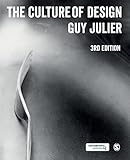The culture of design /
Material type: TextLanguage: English Series: Core textbookPublication details: Los Angeles : Sage, 2014.Edition: 3rd editionDescription: 1 online resource (296 pages) : illustrations. 24cmISBN:
TextLanguage: English Series: Core textbookPublication details: Los Angeles : Sage, 2014.Edition: 3rd editionDescription: 1 online resource (296 pages) : illustrations. 24cmISBN: - 9781446273593
- 320.95 JUL
| Item type | Current library | Collection | Call number | Status | Date due | Barcode |
|---|---|---|---|---|---|---|
 General Books
General Books
|
CUTN Central Library Social Sciences | Non-fiction | 320.95 JUL (Browse shelf(Opens below)) | Available | 45626 |
Chapter 1: Design Culture
Design culture as an object of study
Beyond Visual Culture: Design Culture as an academic discipline
Models for studying Design Culture
Design Culture beyond discipline?
Chapter 2: Design and Production
The rise of design
Freelance, in-house and consultancy design
The establishment of design consultancy
The 1980s design consultancy boom
Neo-fordist design
Post-fordist design
Towards a brand ethos
Speeding up design and production
Design within disorganized capitalism
The new economy
Chapter 3: Designers and Design Discourse
Definitions of design
The word ‘design’ in history
The professional status of design
Designers as ‘Cultural Intermediaries’
Historicity and modernism in design discourse
Second modernity versus design management
Service design
Design Thinking
Chapter 4: The Consumption of Design
The culture of consumption
Design and consumer culture
Passive or sovereign consumers?
De-alienation and designing
Commodities and the aesthetic illusion
Systems of provision
Circuits of culture
Designers and the circuit of culture
Writing about things
Consumption and practice
Anomalous objects
Chapter 5: High Design
Design classics
Mediating production
Consuming postmodern high design: Veblen and Bourdieu
Historicity
Modern designers/modern consumers
Designers, risk and reflexivity
Critical design
Design art
Chapter 6: Consumer Goods
Images
Surfaces
Doing the Dyson
Product semantics
Mood boards
Lifestyles and design ethnography
Back to the workshop
Product semantics and flexible manufacture
Designing global products
Product designers and their clients
Products and brand image
Product use
The iPod: consumption, practice and contingency
Chapter 7: Branded Places
Evaluating place: beyond architectural criticism
The Barcelona paradigm
Cultural economies, regeneration and gentrification
Museums and postindustrial place-making
Beyond nation-states: cities and regions
The branding of city-regions and nations
Problematizing the branding of place
Chapter 8: Branded Leisure
From Fordist to disorganized leisure
Time-squeeze and packaged leisure
The Disney paradigm
Post-tourists
Naked and nowhere at Center Parcs
Televisuality and designing leisure experiences
Dedifferentiation/distinction
Chapter 9: On-screen Interactivity
Computers and graphic design
Technological development and consumer growth
Professional practices
Critical reflection
Authorship
Readership
Consuming interactivity
Cybernetic loss
Liberation and regulation: the bigger picture
Bytes and brands
Chapter 10: Communications, Management and Participation
Internal brand building
The end of advertising
Brand and communications consultancy
Employees as consumers
Aesthetic labour
Designing for creativity
Social participation and design activism
Chapter 11: Networks and Mobile Technologies
iPhones and smartphones
Cyborgs
Closed and open networks
Cultural relativism and technological change
The competition of monopolies
Scipts and metadata
Agencement
Assemblage
Articulation
Boundary objects and spaces
Chapter 12: Studying Design Culture
A design culture turn
Writing design culture
Scope
Closed and open conceptions of design
Reflexivity and historicity
Mediation
Density
Dynamics
Materiality
Concluding remarks
What is the social impact of design? How do culture and economics shape the objects and spaces we take for granted? How do design objects, designers, producers and consumers interrelate to create experience? How do new networks of communication and technology change the design process? Thoroughly revised, this new edition: explores the iPhone, digs deep into the digital with a new chapter on networks and mobile technologies, provides a new chapter on studying design culture, explores the relationship of design to management and the creative industries, supports students with a revamped website and all new exercises. This is an essential companion for students of design, the creative industries, visual culture, material culture and sociology.


There are no comments on this title.